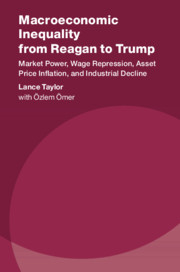 Macroeconomic Inequality from Reagan to Trump
Macroeconomic Inequality from Reagan to Trump Book contents
- Macroeconomic Inequality from Reagan to Trump
- Studies in New Economic Thinking
- Macroeconomic Inequality from Reagan to Trump
- Copyright page
- Contents
- Figures
- Tables
- Acknowledgments
- Introduction
- 1 Decades of Income Inequality
- 2 Macroeconomic Income Distribution
- 3 “Capital,” Capital Gains, Capitalization, and Wealth
- 4 Sectoral Stagnation, Flat Productivity, and Lagging Real Wages
- 5 Institutions and Models for Maldistribution
- 6 Possible Future Prospects
- References
- Index
6 - Possible Future Prospects
Published online by Cambridge University Press: 31 July 2020
- Macroeconomic Inequality from Reagan to Trump
- Studies in New Economic Thinking
- Macroeconomic Inequality from Reagan to Trump
- Copyright page
- Contents
- Figures
- Tables
- Acknowledgments
- Introduction
- 1 Decades of Income Inequality
- 2 Macroeconomic Income Distribution
- 3 “Capital,” Capital Gains, Capitalization, and Wealth
- 4 Sectoral Stagnation, Flat Productivity, and Lagging Real Wages
- 5 Institutions and Models for Maldistribution
- 6 Possible Future Prospects
- References
- Index
Summary
Illustrating how the three income classes may fare under various circumstances is the goal of simulations from a demand-driven model of economic growth discussed in this chapter. It uses the SAM of Figure 2.2 as the database. The model’s key assumptions draw on ideas previously discussed. A succinct list follows.
- Type
- Chapter
- Information
- Macroeconomic Inequality from Reagan to TrumpMarket Power, Wage Repression, Asset Price Inflation, and Industrial Decline, pp. 106 - 121Publisher: Cambridge University PressPrint publication year: 2020
- 3
- Cited by
